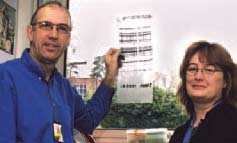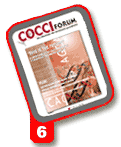Cover Story - 'This is the Future'
IAH's Martin Shirley is leading the way to mapping the Eimeria genome and developing an even better understanding of coccidiosis in poultry
 Shirley and Tomley: 'By sequencing Eimeria DNA, or unraveling its
genetic code, we can open up the parasite"�and come up with
thousands of potential targets for control.'
|
For the moment, coccidiosis can
wait.
Dr. Martin Shirley has just put in
another long day at his lab in Compton,
England, where the world-renowned
coccidiologist serves as principal scientist
for the Institute of Animal Health's
division of molecular biology.
After stopping home to squeeze in
some house painting and taking a long
walk through the quiet countryside,
he's ready to unwind at a pub in his
hometown of Wantage "a quaint 17th
century village some 50 miles northwest
of London.
Sipping on a frothy pint of his
favorite beer, he enthusiastically discusses
his latest accomplishment:
Converting more than 7,500 songs from
his personal CD collection to the MP3
format and cataloging them by artist
and genre on his home PC, which is
wired to a state-of-the-art sound system.
"And I just found a new program
that will allow me to transfer all the old
stuff I have on vinyl to MP3 while eliminating
all the pops and scratches," he
says, clearly embracing the new technology.
"So when I'm all done, I'll have
everything from Dylan, Sam & Dave
and the Stones to Beethoven, Mozart
and Verdi completely catalogued. Every
song will be only a mouse click away."
Cataloging coccidiosis
The following day, when he returns to
his lab at IAH, Shirley is all business.
He's still working at his PC, only this
time he's labeling and cataloging the
DNA of Eimeria parasites, not the vintage
recordings of Led Zeppelin or
Stevie Wonder.
"This is the future of coccidiosis
management in poultry," he says confidently.
"In human medicine, if you look at
the number of drugs available for controlling
diseases, we can effectively hit
about 470 biological targets. That
sounds like a lot, but not when you
consider that our bodies produce something
like 30,000 to 40,000 gene products.
We still have a long way to go.
That's one of the attractions of the
human genome project. Scientists are
opening up the whole genome, so
potentially, we can find and then tackle
every gene that's linked to a particular
disease situation.
"The same is true for Eimeria in
poultry," he adds. "By sequencing
Eimeria DNA, or unraveling its genetic
code, we can open up the parasite for
public display, look at it, dissect it and
come up with maybe thousands of
potential targets for control in the
future."
'Complicated' organism
Shirley notes that Eimeria parasites are
"complicated" organisms with perhaps
up to 10,000 gene products or, put
another way, 10,000 targets for either
direct chemotherapeutic or biological
control.
"At the moment, we have a small
portfolio of coccidiosis drugs and vaccines
that, while very effective, probably
target no more than a half dozen
biological targets, perhaps 10 at the
most.
Coccidiosis Control: How Good Can It Get?
It could be argued that the poultry
industry is already achieving good or at
least adequate control of coccidiosis
with current drugs and vaccines. Still,
Shirley sees plenty of room for improvement. |
"That's one of the reasons we're
sequencing the DNA of Eimeria," he
continues. "For all the progress we've
made against coccidiosis in poultry, we
really know nothing about the finer
points of the biology of Eimeria parasites.
For example, almost nothing is
known about metabolic pathways, the
mechanisms by which the parasite
damages the host or of the molecules
that stimulate protective immunity (i.e.,
how and why vaccines such as
Coccivac and Paracox are so effective).
All of this information is contained in
the genome sequence."
Shirley says his research team at IAH
is concerned primarily with molecular
aspects of the Eimeria genome, as well
as the genetics of the parasites.
"Without doubt, the most exciting
spin-off from our work has been our
recent success in securing the funding
of a genome sequencing project for
Eimeria tenella, which causes cecal coccidiosis
in chickens," he says. "This is a
fantastic outcome for the coccidiosis
community worldwide, as E. tenella has
become the first protozoan of global
veterinary importance to be sequenced
on a large scale."
Dream team
In March 2002, Shirley, IAH colleague
Dr. Fiona Tomley and Drs. Bart Barrell
and Al Ivens from the Sanger Institute,
Cambridge, were awarded a grant of
£750,000 (US$1.2 million) from the UK's
Biological and Biotechnological Science
Research Council to determine the DNA
sequence for the world reference
Houghton strain of E. tenella.
"Our previous work has shown that
the genome of E. tenella comprises
about 60 million base pairs of DNA
contained within 14 chromosomes,"
says Shirley, who expects to wrap up
the project by June 2004. "This amount
of DNA may give rise to around 8,000
to 10,000 different proteins. But at present,
literally only a small handful of
these proteins have been identified and
only very few of the genes responsible
have been characterized."
When the project is finished in June
2004, Shirley's team will have assembled
a genetic blueprint for E. tenella
and revealed 90% of the parasite's
encoded proteins. All the data generated
by the project is being posted on the
Internet and available to the public.
Shirley says the data will allow current
and future coccidiologists to identify
new targets for vaccination and
chemotherapy.
Eimeria's 'lifestyle'
"The data will yield a much greater
understanding of how Eimeria parasites
go about their lifestyle "for example,
how they cause disease, find the correct
parts of the gut in which to develop,
get into the host cells, reproduce themselves,
cause the host to develop
immune responses, and a myriad of
other biological features," Shirley
explains.
"In addition, the data will allow the
biology of Eimeria parasites to be compared
with that of close relatives, such
as Plasmodium (the malarial parasites),
Cryptosporidium, Neospora and Toxoplasma.
If one of these parasites
invades in a particular way, for example,
you can be sure that Eimeria probably
invades the host cell in a similar
way. In the research community, there's
a lot of mixing and matching between
these different organisms."
The sequencing initiative under way
at the IAH and the Sanger Institute was
provided with many letters of support
from international scientists and veterinarians
working on coccidial parasites
and coccidiosis. Shirley says the funding
of the work by the BBSRC represents
a major push for veterinary science.
"To date, the genomes of very
few pathogens of purely veterinary
importance have been sequenced, and
none remotely as big as E. tenella" he
says.
But Shirley and his colleagues at
IAH and Sanger are not going at this
alone. The UK scientists are also collaborating
with sequencing efforts by Dr. Arthur Gruber in São Paolo, Brazil,
and Dr. Wan Kiew Lian at the Universiti
Kebangsaan, Malaysia.
"Arthur is doing some great research
that dovetails in to the big sequencing
initiative and Wan has been awarded a
grant from the Malaysian government
to derive the complete sequence of
chromosomes 1 and 2 (each of 1 million
base pairs of DNA)," Shirley says.
"These chromosomes will be
sequenced in their entirety to capture
all genes and, most interestingly, chromosome
2 is linked to the trait of precocious
development that characterizes
the attenuated parasites used in
Schering-Plough Animal Health's
Paracox, the current attenuated vaccine."
Why Target Eimeria?
Eimeria is the most economically significant family of parasites for poultry and intensively
reared livestock, according to Dr. Martin Shirley of IAH.
"Coccidiosis has most impact in the intensive poultry industry, where all 35 billion
chickens raised annually are likely to become infected," he says. "Despite routine
prophylaxis with anticoccidial drugs, coccidiosis costs the UK poultry industry alone
around £40 million ($64 million) a year, which is equivalent to 4.5% of the revenue from
sales of live broilers."
Subclinical coccidiosis is commonplace because the efficacy of drugs is severely
compromised by drug-resistant parasites, Shirley says. In the EU, coccidiosis is also
considered a "severe welfare problem" causing malabsorption, weight loss, diarrhea,
hemorrhaging, anemia and death.
"Eimeria tenella is one of the most common and pathogenic species that infect the
domestic chicken and the disease of cecal coccidiosis is one of the most highly visible
aspects of coccidiosis in poultry," he says. "Coccidiosis control is complex and it
seems clear that sustainable control will rely increasingly on vaccination, either
alone or in combination with drugs."
But don't expect coccidiosis to be eradicated any time soon.
"Eimeria is fantastically suited for survival and replication, especially in circumstances
"warmth, moisture, high bird density "provided so wonderfully by the
poultry industry," Shirley says. "For example, the
oocysts have a transmission stage that is extremely
robust and tough. In fact, in the laboratory, we
can incubate these in bleach and the parasites still
survive very well."
"The parasite itself is a bit like a Russian doll, with
four discrete genomes inside it," he adds. "Once
the Eimeria parasite gets into the host, it really kicks
in with a large range of genomes."
Solving the Eimeria Puzzle
Scientists use one of four letters "A,
C, G or T "to identify each DNA molecule
within a chromosome. These letters
occur in pairs (A with T and C with
G) and, in total, the 14 chromosomes in
the Eimeria organism contain about 60
million such pairs of DNA. |
Source: CocciForum Issue No.6, Schering-Plough Animal Health.







